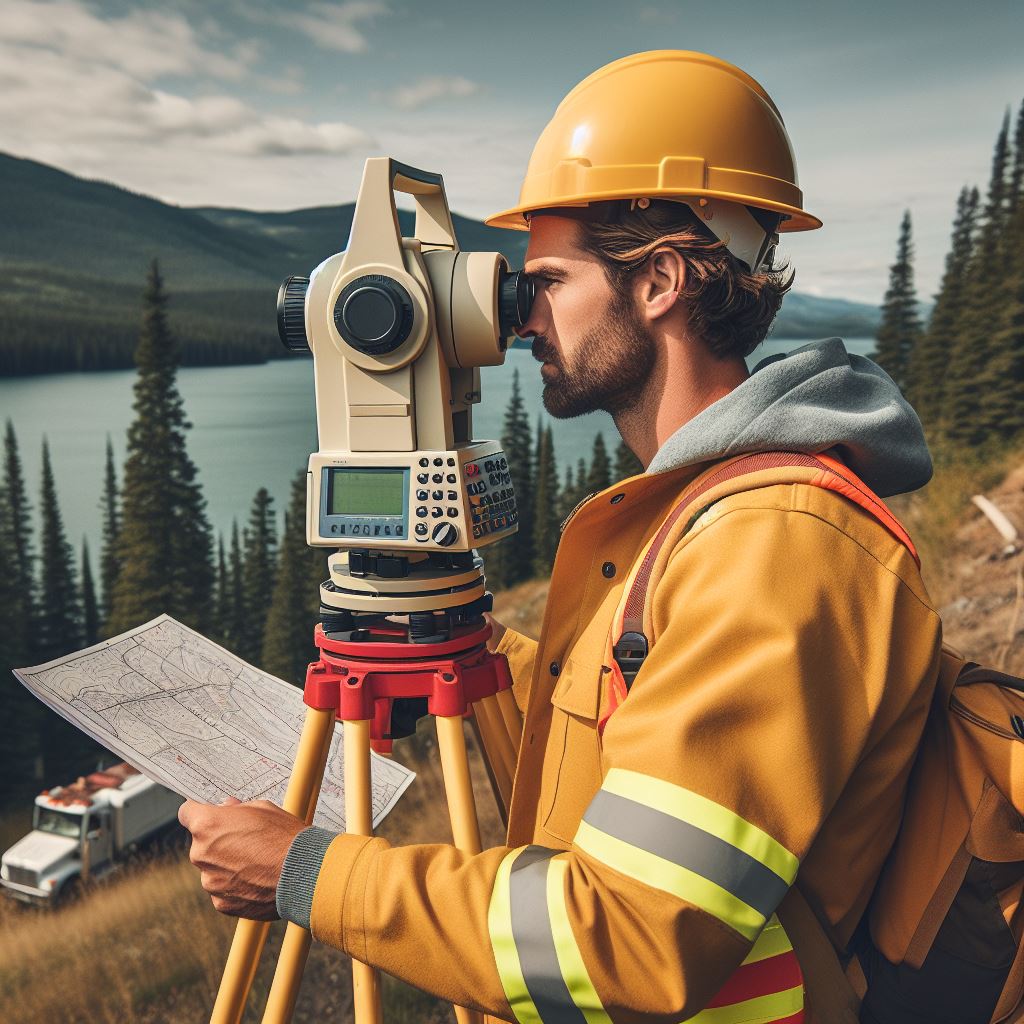Introduction
A. Canadian Surveyors: Mapping the Day
Canadian surveyors are unsung heroes, shaping landscapes and urban environments.
From sunrise to sunset, their work is a meticulous dance with precision instruments and rugged terrains.
B. Purpose of the Blog Post
This blog unveils the mystery behind a Canadian surveyor’s routine.
Explore the challenges, tools, and moments that define their daily grind.
Whether you’re a fellow surveyor or just curious, get ready for a journey into the heart of this fascinating profession.
- Insights into Routine: Uncover the structured chaos of a surveyor’s day, from pre-dawn equipment checks to post-sunset data analysis.
- Tools of the Trade: Dive into the sophisticated instruments that Canadian surveyors wield – theodolites, GPS devices, and cutting-edge mapping software.
- Challenges Faced: Discover the obstacles these professionals navigate daily, be it unpredictable weather or the intricacies of varied landscapes.
- Collaboration and Communication: Peek into the collaborative efforts and effective communication required among surveying teams to ensure seamless operations.
Embark on a journey through the lens of a Canadian surveyor, where precision meets passion, and every plot of land tells a unique story.
Education and Certification
A. Education and Training: Building the Foundation
- To embark on the journey of becoming a Canadian surveyor, a solid educational foundation is crucial.
- Prospective surveyors typically pursue a bachelor’s degree in surveying, geomatics, or a related field.
- Key courses cover subjects like land surveying, geodetic science, and Geographic Information Systems (GIS).
- Practical training, often gained through internships, helps bridge the gap between theory and real-world applications.
- Emphasizing fieldwork, programs instill skills in using advanced surveying instruments and cutting-edge technologies.
- Building proficiency in data analysis, computer-aided design, and geographic information systems is integral to the curriculum.
- Successful candidates often supplement their degree with specialized certifications and workshops.
B. Certification and Licensing: The Professional Seal of Approval
- Certification is the cornerstone of a surveyor’s professional credibility and competence.
- The Association of Canada Lands Surveyors (ACLS) is a key authority responsible for certification standards.
- Upon completing the required education and training, aspiring surveyors must pass the Professional Examination administered by the ACLS.
- The certification process evaluates candidates’ knowledge, skills, and ethical understanding.
- Obtaining a professional license is the next crucial step after certification.
- Licensing, granted by provincial or territorial surveying authorities, legally authorizes surveyors to practice in a specific region.
- Holding a license signifies adherence to industry standards, ethics, and a commitment to ongoing professional development.
- Continuous learning is emphasized, and surveyors are encouraged to attend workshops and conferences to stay abreast of technological advancements.
- Government projects, land development, and legal boundaries often require the expertise of licensed surveyors.
- The public relies on the accuracy and reliability of surveys, making certification and licensing essential safeguards.
In the dynamic field of surveying, education lays the groundwork, while certification and licensing elevate a surveyor to the pinnacle of professionalism, ensuring precision and trust in every plotted point.
Read: Essential Skills for Canadian Architects
Typical Work Environment
A. The work environment of a Canadian surveyor, which can vary between field and office work
In the typical work environment of a Canadian surveyor, there are two main settings: field work and office work.
During field work, surveyors often find themselves outdoors, braving different weather conditions.
They may have to hike long distances, traverse steep terrains, or even wade through water bodies.
This physically demanding aspect of their job requires them to be fit and prepared for various challenges.
B. The equipment and tools commonly used by surveyors
Surveyors rely on a range of equipment and tools to carry out their work accurately.
Theodolites, for instance, are essential instruments used for measuring precise angles and distances.
Similarly, total stations, which integrate electronic distance measurement with theodolite functions, provide accurate data for creating maps and setting up construction sites.
1. Global Navigation Satellite Systems (GNSS)
Global Navigation Satellite Systems (GNSS), such as Global Positioning System (GPS), are also commonly used by Canadian surveyors.
These systems help determine precise positions on the Earth’s surface, making surveying more efficient and accurate.
2. Laser scanners and drones
Other tools include laser scanners, which capture detailed 3D images of objects or environments, and drones equipped with cameras that aid in aerial surveys.
Surveyors also employ measuring tapes, tripods, and leveling instruments to measure distance, elevation, and angles.
3. Computer-Aided Design (CAD) programs
In the office, surveyors analyze and process the data collected in the field.
They use specialized software, like Computer-Aided Design (CAD) programs, to create maps, charts, and reports based on the field measurements.
This enables them to provide accurate and comprehensive data to clients and other professionals.
Moreover, surveyors spend their office time conducting research, reviewing historical maps, and consulting legal documents related to property boundaries.
They also communicate with clients, contractors, and other stakeholders to discuss project requirements and resolve any issues that may arise.
To excel in their work, surveyors must possess skills such as problem-solving, attention to detail, and the ability to work both independently and as part of a team.
Unlock Your Career Potential
Visualize a clear path to success with our tailored Career Consulting service. Personalized insights in just 1-3 days.
Get StartedThey must also have strong mathematical and analytical skills to interpret the survey data accurately.
Surveyors often enjoy the diversity of their work environment, as they get to experience the challenges of the field and the comforts of the office.
This dynamic balance allows them to apply their technical expertise in different settings and contribute to various projects, ranging from land development and construction to environmental preservation and infrastructure planning.
Read: Diversity in Canada’s Architectural Sector
Daily Tasks and Responsibilities
A. Tasks and responsibilities that Canadian surveyors usually perform
As a Canadian surveyor, your daily tasks and responsibilities revolve around ensuring accuracy and attention to detail.
Here are the main tasks performed by Canadian surveyors:
1. Conducting Surveys
- Measure distances, angles, and elevations using advanced surveying tools and technologies.
- Establish control points to provide accurate references for future surveys.
- Create precise boundary surveys to determine land ownership and resolve property disputes.
- Survey construction sites to ensure proper placement of buildings and infrastructure.
2. Collecting Data
- Collect data through field observations, measurements, and recordings.
- Gather information on land features, topography, and geographical characteristics.
- Use GPS and laser scanning techniques to capture detailed data points.
3. Analyzing Data
- Process and analyze collected data using specialized software and computer-aided design (CAD) tools.
- Prepare detailed maps, charts, and reports based on the analyzed data.
- Apply mathematical calculations to determine precise measurements and coordinates.
4. Collaborating with Team Members
- Coordinate with other surveyors, engineers, architects, and construction professionals to ensure project alignment.
- Communicate survey findings and recommendations to project stakeholders.
- Facilitate teamwork and coordinate efforts to meet project deadlines.
5. Ensuring Compliance
- Adhere to local, provincial, and national regulations and standards in surveying practices.
- Verify the accuracy and validity of survey data to ensure legal compliance.
- Stay updated with the latest laws and regulations related to land surveying in Canada.
B. Importance of Accuracy and Attention to Detail
Accuracy and attention to detail are crucial in the field of surveying for the following reasons:
1. Reliable Decision-making
Precise measurements and data ensure reliable decision-making in various industries, such as construction, resource exploration, and urban planning.
2. Legal Compliance
Accurate surveys establish property boundaries and provide evidence in legal disputes, ensuring compliance with land ownership laws.
3. Safety and Risk Management
Surveying accuracy helps identify potential risks and hazards, ensuring the safety of construction projects and minimizing environmental impact.
4. Financial Impact
Inaccurate surveys can result in costly errors, such as misplaced infrastructure, leading to financial losses and project delays.
5. Infrastructure Development
Precise surveys contribute to the successful planning and execution of infrastructure projects, promoting sustainable development.
6. Professional Reputation
Maintaining a reputation for accuracy and attention to detail establishes trust with clients and enhances professional credibility.
In essence, Canadian surveyors perform various tasks, including conducting surveys, collecting and analyzing data, collaborating with team members, and ensuring legal compliance.
Accuracy and attention to detail are paramount for reliable decision-making, legal compliance, safety, financial impact, infrastructure development, and maintaining a professional reputation.
Read: Mech Engineers: Climate Change Role
Field Work
A. The activities involved in field work for Canadian surveyors
Canadian surveyors engage in various activities during field work, which is a vital part of their job.
They conduct surveys to measure and map land, including determining property boundaries and topography.
One of their responsibilities is to set up surveying equipment, such as total stations and GPS receivers.
They use these instruments to collect accurate data on angles, distances, and elevations.
Surveyors also utilize computer software to process the collected data and create detailed maps and reports.
During field work, surveyors often work in teams to ensure efficiency and accuracy in their measurements.
They collaborate with other professionals, such as engineers and architects, to provide accurate data for construction projects.
Surveyors may need to travel to different locations, sometimes working in remote and challenging terrains.
B. The challenges encountered while working outdoors, such as adverse weather conditions
While working outdoors, Canadian surveyors face numerous challenges, including adverse weather conditions.
They might need to brave extreme temperatures, heavy rain, snowstorms, or even deal with insects and wildlife.
Precise measurements can be demanding during inclement weather, as it affects visibility and equipment performance.
Surveyors have to take precautions and adapt their methods accordingly to ensure data accuracy.
In addition to weather challenges, surveyors must also navigate difficult terrains, such as rugged mountains or dense forests.
They may have to hike long distances, carry heavy equipment, or even use specialized tools for particular environments.
Working in remote areas can bring isolation, limited access to resources, and difficulties in communication.
Despite these challenges, the field work of Canadian surveyors can also be exhilarating and rewarding.
They get the opportunity to explore different landscapes, contribute to important projects, and make a lasting impact.
Field work enables surveyors to appreciate the beauty of Canada’s natural surroundings while fulfilling their professional duties.
The experience gained in the field is invaluable, allowing them to continuously develop their skills and expertise.
Field work remains an essential component of a Canadian surveyor’s life, offering a unique blend of challenges and fulfillment.
Read: Mech Engineering: Women in the Field

Office Work
A. The tasks and activities that Canadian surveyors perform in the office
Canadian surveyors perform a variety of tasks and activities in the office that are essential to their work.
1. Data Processing
- Surveyors use specialized software to process the data collected during field surveys.
- They input the survey measurements and observations into the software for analysis.
- This software helps them produce accurate maps, charts, and reports.
2. Data Analysis
- Surveyors analyze the processed data to identify patterns, trends, and anomalies.
- They use statistical tools and techniques to make sense of the survey results.
- This analysis provides valuable insights for various projects and land developments.
3. Report Writing
- Surveyors are responsible for preparing detailed reports based on their findings.
- These reports include information about the survey objectives, methods used, and the results obtained.
- Clear and concise reports help convey the survey findings to clients, government agencies, or other stakeholders.
4. Quality Control
- Ensuring the accuracy and reliability of survey data is crucial for surveyors.
- They check and review the processed data to identify any errors or inconsistencies.
- This quality control process ensures that the final results are precise and trustworthy.
5. Project Planning
- Surveyors participate in project planning meetings to discuss the requirements and objectives.
- They provide valuable input on the surveying aspects of the project, such as mapping and boundary determination.
- This collaboration ensures that the survey work aligns with the overall project goals.
6. Communication
- Surveyors regularly communicate with clients, team members, and stakeholders.
- They discuss project progress, address any concerns or questions, and provide updates.
- Clear and effective communication is essential to ensure a successful surveying project.
7. Equipment Maintenance
- Surveyors are responsible for the maintenance and calibration of their surveying equipment.
- They ensure that the instruments are in proper working condition for accurate data collection.
- This includes regular cleaning, calibration, and troubleshooting if any issues arise.
8. Continuing Education
- Surveyors engage in continuous learning to stay updated with the latest advancements in surveying technology.
- They attend conferences, workshops, and training sessions to enhance their skills and knowledge.
- By staying current, surveyors can provide the best possible services to their clients.
In general, the office work of Canadian surveyors involves various tasks and activities that contribute to the successful completion of surveying projects.
From data processing and analysis to report writing and communication, surveyors rely on specialized software, technology, and their expertise to provide accurate and reliable survey data.
Collaboration and Communication
A. The importance of collaboration and effective communication skills in the work of Canadian surveyors
the importance of collaboration and effective communication skills in the work of Canadian surveyors
Collaboration and effective communication skills are crucial in the work of Canadian surveyors.
The ability to work together and effectively communicate ensures successful outcomes.
B. Interactions with Clients
- Canadian surveyors often have direct interactions with clients, understanding their needs and expectations.
- Active listening is key to accurately grasping client requirements and ensuring their satisfaction.
- Regular communication with clients throughout the surveying process helps address any concerns or changes promptly.
- Through collaboration, surveyors can align their work with client goals, ensuring a smooth project execution.
C. Interactions with Engineers and Professionals
- Close collaboration with engineers is essential to ensure accurate measurement and alignment of structures.
- Surveyors work hand-in-hand with engineers to ensure that projects adhere to safety standards and regulations.
- Regular communication with engineers helps resolve any technical issues or challenges that may arise.
- Surveyors also interact with professionals from other related industries such as architects and urban planners.
- These interactions allow for interdisciplinary collaboration, resulting in well-coordinated projects.
D. Significant role effective communication skills
Effective communication skills play a significant role in these interactions:
- Clear and concise communication ensures that all parties understand project requirements and objectives.
- Timely communication helps avoid misunderstandings and keeps projects on track.
- Collaborative problem-solving fosters innovation, as different perspectives and expertise are brought together.
- Active communication with team members enhances efficiency and minimizes errors or rework.
- Through effective communication, surveyors can provide regular updates to all stakeholders involved in a project.
E. Benefit collaboration and communication
Collaboration and communication skills not only benefit the surveyors but also contribute to overall project success:
- Smooth collaboration ensures that projects are completed within the agreed timeframe and budget.
- Effective communication reduces the risk of errors and improves the overall quality of surveying work.
- Successful collaboration fosters long-term relationships with clients and professionals in the industry.
- Through collaboration, surveyors can leverage their expertise and learn from others, enhancing professional development.
- Improved communication leads to increased client satisfaction, further fostering a positive reputation for surveyors.
In a nutshell, collaboration and effective communication skills are vital in the daily life of Canadian surveyors.
They enable successful interactions with clients, engineers, and other professionals in the industry, leading to the overall success of surveying projects.
Career Prospects
In the field of surveying, Canadian surveyors have a range of career prospects and growth opportunities available to them.
A. The career prospects available to Canadian surveyors
- Canadian surveyors have a high demand for their skills due to ongoing infrastructure development projects.
- Opportunities exist in both the public sector, such as government agencies, and the private sector, including engineering and consulting firms.
- Surveyors can find employment across various industries, including construction, mining, forestry, and land development.
- With the increasing need for accurate boundary surveys, surveyors can establish their own independent practices.
B. Growth Opportunities available to Canadian surveyors
- Surveyors can advance their careers by gaining experience and becoming licensed professionals.
- As licensed surveyors, they can take on more complex projects and assume greater responsibilities.
- Specialization is also possible, allowing surveyors to focus on specific areas such as geodetic surveying or hydrographic surveying.
- Advancements in technology, such as aerial drones and advanced GPS systems, have created new growth opportunities.
- Surveyors can enhance their skills by staying up-to-date with the latest advancements in surveying technology.
- Continuing education programs and professional development courses offer avenues for further growth.
C. The potential for advancement and specialization within the field
Canadian surveyors enjoy significant career prospects and specialization opportunities due to high demand for their expertise. Whether in the public or private sector, they ensure precise measurements.
To advance, surveyors obtain licenses, enabling them to handle more challenging projects, fostering professional growth and recognition.
Specialization in areas like geodetic or hydrographic surveying distinguishes their expertise.
Surveying constantly evolves with technological advancements. Embracing tools like aerial drones and advanced GPS systems ensures competitiveness and efficiency in data collection.
Continued learning through education programs and professional development is vital.
Participation in these programs expands knowledge, keeping surveyors updated on emerging trends and the latest techniques.
To summarize, Canadian surveyors navigate a diverse range of career prospects with growth potential.
The profession’s demand, opportunities for specialization, and adaptation to technological advancements make surveying rewarding.
Staying current with technology and engaging in professional development position surveyors for success in this dynamic field.
Conclusion
In this blog post, we explored the daily life of a Canadian surveyor and gained valuable insights into their profession.
Canadian surveyors play a significant role in various construction projects, ensuring accuracy and precision in measurements and mapping.
They are responsible for providing crucial information to architects, engineers, and builders, which helps in planning and executing construction projects efficiently.
The impact of Canadian surveyors extends beyond construction, as their expertise is also valuable in land development, urban planning, and environmental management.
By analyzing the main points discussed in this blog post, we can appreciate the importance of Canadian surveyors in the construction industry.
Their role in ensuring precise measurements, identifying potential challenges, and providing accurate data contributes to the success and safety of construction projects.
Without their expertise, construction projects could face delays, cost overruns, and even structural issues.
If you have found the daily life of a Canadian surveyor intriguing, we encourage you to explore this profession further.
It offers diverse opportunities for those interested in both the outdoors and technology.
Working as a surveyor can be intellectually stimulating, physically active, and provide you with a sense of accomplishment as you contribute to the development of communities and infrastructure.
Canadian surveyors are vital professionals in the construction industry, ensuring accurate measurements and mapping that form the foundation of successful projects.
Their work influences the safety, efficiency, and overall success of construction endeavors, and they play a vital role in shaping the built environment.
So, consider further exploration if you have an interest in this dynamic profession.




